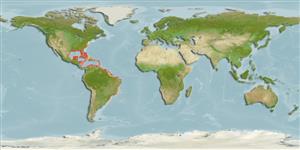Classification / Names
Common names from other countries
Main reference
Size / Weight / Age
Max length : 38.8 cm TL male/unsexed; (Ref. 26340); common length : 20.0 cm TL male/unsexed; (Ref. 3821); max. published weight: 400.00 g (Ref. 5217)
Length at first maturity
Lm 10.8 range ? - ? cm
Environment
Marine; brackish; reef-associated; depth range ? - 48 m (Ref. 9710)
Climate / Range
Subtropical, preferred ?; 42°N - 35°S, 98°W - 34°W
Distribution
Short description
Dorsal
spines
(total): 0;
Dorsal
soft rays
(total): 11-12;
Anal
spines: 0;
Anal
soft rays: 11. Greenish above, pale yellow to white below; back has series of pale lines and arcs suggesting concentric circles with intersecting lines. No other puffer has this color pattern (Ref. 26938).
IUCN Red List Status (Ref. 115185)
Threat to humans
Poisonous to eat (Ref. 3821)
Human uses
Fisheries: of no interest
More information
ReferencesAquacultureAquaculture profileStrainsGeneticsAllele frequenciesHeritabilityDiseasesProcessingMass conversion
Tools
Special reports
Download XML
Internet sources
Estimates of some properties based on models
Phylogenetic diversity index
PD50 = 0.5000 many relatives (e.g. carps) 0.5 - 2.0 few relatives (e.g. lungfishes)
Trophic Level
3.4 ±0.48 se; Based on food items.
Resilience
Low, minimum population doubling time 4.5 - 14 years (K=0.51; rel. fec=1.146 eggs/ g body weight)
Vulnerability
Low vulnerability (22 of 100)
Price category
